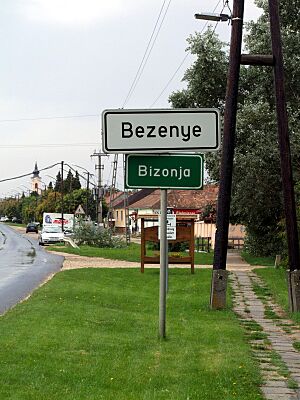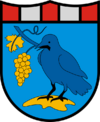Bezenye facts for kids
Quick facts for kids
Bezenye
Bizonja
|
|||
|---|---|---|---|

Bilingual city limit sign
|
|||
|
|||
| Lua error in Module:Location_map at line 416: Malformed coordinates value. | |||
| Country | Hungary | ||
| County | Győr-Moson-Sopron | ||
| Area | |||
| • Total | 30.03 km2 (11.59 sq mi) | ||
| Population
(2012)
|
|||
| • Total | 1,393 | ||
| Population by ethnicity (2011) | |||
| • Hungarians | 80.2% | ||
| • Croats | 30.5% | ||
| • Slovaks | 9.0% | ||
| • Germans | 4.4% | ||
| • Other | 0.8% | ||
| • Unreported | 12.9% | ||
| Population by religion (2011) | |||
| • Roman Catholic | 66.0% | ||
| • Calvinists | 1.0% | ||
| • Other | 0.8% | ||
| • Non-religious | 8.1% | ||
| • Unreported | 24.0% | ||
| Area code(s) | 96 | ||
| Motorways | M15 | ||
| Distance from Budapest | 174 km (108 mi) Southeast | ||
Bezenye is a small village in Győr-Moson-Sopron County, Hungary. It is also known by its Croatian name, Bizonja, and its German name, Pallersdorf. The village is located very close to the Slovak border. It is only about 25 kilometers (15 miles) from Bratislava, which is the capital city of Slovakia.
Bezenye is a special place because many different cultures live there. Most people are Hungarians, but there is also a large group of Croats. You can also find smaller groups of Slovaks and Germans. Because of this mix, people in Bezenye often speak a blend of languages.
Contents
Exploring Bezenye's Past
Early Settlers and Ancient Finds
Long ago, the first people to live in the Bezenye area were Germanic tribes. We know this because archaeologists have found many old items from their time. You can see these interesting artifacts at the Hanság Museum. This museum is in the town of Mosonmagyaróvár, which is about 25 kilometers (15 miles) away.
A Village Reborn
Later, Magyar people settled in Bezenye. But then, the village was attacked by Turkish troops. After this, the village slowly started to grow again. Many new people came to live there. A large number of these new residents were Croatian communities from Dalmatia. Germans also moved to Bezenye. The Germans called the village "Palersdorf," and the Croatians called it "Bizonja." The name Bezenye itself comes from an old Slav word. It means "elder" tree, like the plant.
German Settlers and Saltpeter
The German people who settled in Bezenye had a special job. They worked on making saltpeter. This was an important substance used for different purposes back then.
Changes After World War II
After World War II, many German families who were not wealthy had to move to Germany. Then, several Hungarian families came to live in Bezenye. Some of these families had moved from Slovakia. There was a request to make Bezenye part of Slovakia, along with some nearby villages. However, this request was not accepted.
Life in Bezenye Today
Bezenye has a small museum that tells the story of the village. It shows how the village has changed over time. The local Roman Catholic church is called the Church of the Blessed Virgin Mary. Services there are held in both Croatian and Hungarian. This shows how important both languages are to the community. The village also has its own Croatian self-administration. This means the Croatian community has a say in local decisions.
Famous People from Bezenye
- Mátyás Laáb (1746-1823) was a Burgenland Croatian writer and translator. He was born in Bezenye.
See also
 In Spanish: Bezenye para niños
In Spanish: Bezenye para niños



